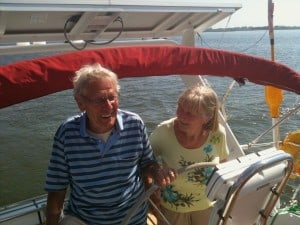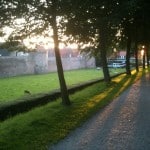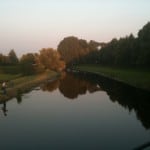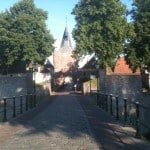We rather reluctantly left Marken and had a gentle sail eastwards across the Markermeer to off Lelystad, where we passed through a lock and out into the IJseelmeer. From there we passed round the northern end of Oostelijk Flevoland and into the Ketelmeer, where we anchored overnight before heading round Flevoland and south for Elburg.
Oostelijk Flevoland is a vast polder created out the IJsselmeer in the 1950s to make more land. The new town of Lelystad thereon has taken a lot of overspill from Amsterdam (UK readers: think Milton Keynes). A narrow channel has been left between the polder and the old land on which Elburg stands. This water is much used recreationally, and there are lots of beaches, marinas and mooring jetties, but with little opportunity for sailing. This is definitely cruiser water.
Elburg is a lovely old town, which was once an important port and town in the Zuiderzee’s golden age. Following floods in the middle ages it was rebuilt in a square grid pattern, with defensive walls, a dyke and a wide moat (see below left and middle). The dyke and moat remain complete, surrounding the old town with its narrow streets and a crossing of water in the centre. The gate from the port (see right below) has a lantern high up, which was the leading mark for ships entering the port. Tony has visited Elburg twice before, out of season, and it seems a lovely genteel place.
So nothing had prepared us as we rounded the corner towards the harbour, where the waterway was seething with every kind of boat imaginable, and it was quite tricky edging our way between boats, inflatables and swimmers. It should be noted that the weather had turned hot, and, due to the Flevoland polder, we were now a long way from expansive water. The locals keep cool by getting onto or in what water is left. Waiting on the shore were Trees (Ynskje’s mother) and her husband Ton, who had cycled over from Vierhouten to greet us. We eventually managed to find a mooring at the Elburger Botters wharf, where they looked after us well.
Botters are the traditional Dutch boats, with their turned up noses and wide beams, shaped something like a shallow bath tub. They are very suited for the shallow waters and many are quite voluminous. Once made of wood, many modern botters are of steel. They are heavy boats and it requires heavy gear to handle them, and a number of places such as Elburg have centres/clubs where they can be slipped, restored or maintained.
To add to the chaos of Elburg, a fair was setting up by the harbour, and in due course we were blasted by loud ‘music’ for over twelve hours a day. Ynskje and I did take a ride on the Super Mouse, which is a modern successor to the Big Dipper Tony recalls from years ago. This modern version has cars that seem to go round almost right-angle bends. In addition to the usual ups and downs, the cars sometimes spin round and round at the same time. We survived – but took a while to come to terms with the experience.
 On Thursday Ton & Trees came on board for the day. It was lovely weather with a gentle breeze. We made an excursion to the Veluwemeer some seven nautical miles away, where we anchored out in the middle for a lazy lunch and swim. It was a lovely interlude. On Friday Ton & Trees came on their cycles to meet us and we all cycled back to their home in Vierhouten. That evening we walked to a nearby Dutch Pancake House for supper.
On Thursday Ton & Trees came on board for the day. It was lovely weather with a gentle breeze. We made an excursion to the Veluwemeer some seven nautical miles away, where we anchored out in the middle for a lazy lunch and swim. It was a lovely interlude. On Friday Ton & Trees came on their cycles to meet us and we all cycled back to their home in Vierhouten. That evening we walked to a nearby Dutch Pancake House for supper.
On Saturday we sailed (well, motored in good part) from Elburg, round the Flevoland polder and out into the Ketelmeer, from where we sailed to Urk. Urk was once an island in the former Zuiderzee, but became part of the Noord Oost Polder in the 1940s. Although cut off from the sea proper, it remains an important fishing port, with North Sea fish being trucked in by lorry for the fish auctions. Our guide describes Urk as the most fascinating town of all. It is unusual in that it is on a hill some 25m high – a rarity around here. But we felt it was over-hyped. It is quite touristy and there is little going for it, unless you are into dead fish in a big way.
On Monday we sailed from Urk into a stiff Force 5-6 across the IJselmeer to Enkhuisen and the lock back into the Markermeer and thence to Hoorn. This was the first hard sail we have had for a considerable time, and also showed us the short choppy seas that the shallow waters here can create. Especially in the second part, after the wind had moderated, it was a magnificent sail.
We are now anchored in the Hoorn Buitenhaven (outer harbour), and are waiting the arrival of Ynskje’s daughter Sarah and friend Nem on Wednesday. See the Cruise Plans for the latest update.
much love as ever
Ynskje & Tony



